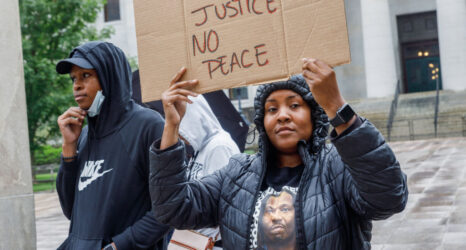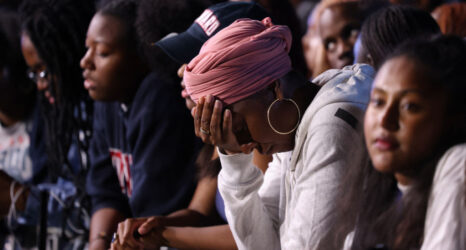In the past two years, anti-rape activists have put campus sexual assault on the national policy agenda—but in recent months, the backlash against these efforts has intensified. A band of political conservatives are now openly challenging the existence of the campus rape epidemic and denigrating survivors, including talk show hosts Glenn Beck and Laura Ingraham, columnists George Will, Jay Ambrose, Cathy Young and Naomi Schaefer Riley, representatives from the Foundation for Individual Rights in Education (FIRE) and the American Enterprise Institute, and many others. This is not the first time conservatives have orchestrated a backlash against anti-violence efforts on college campuses.
What is happening today is a tired re-enactment of the backlash that started in 1985 with the publication of “Date Rape: The Story of an Epidemic and Those Who Deny it” in Ms. The article reported on Dr. Mary Koss’s three-year study of more than 7,000 students at 35 schools that found sexual assault was common and mostly committed by acquaintances and friends. Koss’s groundbreaking work made “date rape” a part of the national dialogue, but it also inspired a tremendous backlash from men’s rights activists (MRAs), Playboy and others over whether or not this type of sexual assault constituted “real rape.” The backlash was so intense, in fact, that in 1994, Katie Roiphe, an undergraduate English major with no social science training, garnered a book contract and national attention for her anti-date-rape tome, The Morning After: Fear, Feminism, and Sex. In it, Roiphe dismisses Koss’s data based on a gross misunderstanding of basic statistics, and clings to the idea that victims of date rape are partially to blame because of their drug and alcohol intake. This concerted effort by conservatives effectively dampened public outrage and action around the issue.
Much like the backlash of the 1980s and ’90s, today’s rape apologia comes in four distinct, but interconnected, forms: denying the problem exists, blaming the victim, vilifying whistleblowers and turning perpetrators into victims. Below, we outline the ways in which conservative backlashers are attempting to undermine the work of anti-rape activists—and, thankfully, how they’re failing.
Rape Truthers
The most popular backlash tactic is to challenge the data. “Rape truthers,” as we like to call them, criticize the sample selection and response rate of the 2007 Campus Sexual Assault (CSA) study, the basis for the White House statistic that 1 in 5 college women face attempted or completed sexual assault. What these rape truthers fail to mention is that the CSA figures are almost the same as a 2007 Medical University of South Carolina study, a 2010 Centers for Disease Control study and a 2010 Harvard School of Public Health study, all of which used different methodologies. The stat also dates back three decades to Koss’s Sexual Experiences Survey.
Other rape truthers challenge the 1 in 5 statistic because they do not think that “incapacitated sexual assault” is “real rape.” Conservative columnist Cathy Young writes that “a far better solution would be to draw a clear line between forced sex (by violence, threats or incapacitation) and unwanted sex due to alcohol-impaired judgment, miscommunication or verbal pressure.” Naomi Schafer Riley states that “there’s been no epidemic of assault but instead a preponderance of sexual encounters fueled by bad judgment and free-flowing alcohol.” These ideas sound oddly similar to men’s rights activist Warren Farrell‘s assertion in the 1990s that “date rape” was “buyer’s remorse.” Today, MRAs are challenging the definition of rape, taking to the streets to plaster posters with “just because you regret a one night stand doesn’t mean it wasn’t consensual” and targeting the anonymous rape reporting systems at Occidental College and Dartmouth College.
The problem with the “real rape” argument is that it ignores state law. All 50 states [pdf] have laws that say an incapacitated party cannot consent to sex, with some variations on the definition of “incapacitation.” For example, “incapacitation” in Colorado is defined as being “physically helpless,” “unconscious, asleep, or otherwise unable to indicate willingness to act,” or “substantially impaired from any drug or intoxicant.” Florida defines “incapacitation” as “mentally incapacitated” or “temporarily incapable of appraising or controlling a person’s own conduct due to the influence of a narcotic, anesthetic, or intoxicating substance administered without his or her consent or due to any other act committed upon that person without his or her consent.”
Victim Blamers
There are many outspoken conservatives we’d consider “victim blamers”—including Slate advice columnist Emily Yoffe— who place the onus on young women to prevent rape in ways that are both damaging and distracting. For example, on October 15, Yoffe penned a piece entitled, “The Best Rape Prevention: Tell College Women to Stop Getting Drunk.” Beyond blaming survivors, Yoffe inaccurately classified rape as a drunken miscommunication problem instead of a serial rape problem. Dr. David Lisak’s research on undetected rapists found that just 4 percent of young male students commit nine out of 10 rapes on college campuses, with an average of six rapes each over the course of their college careers. Serial campus rapists’ principal weapon is alcohol, and they are able to hide in plain sight within a male-dominated party culture where men provide the venues, parties and drinks to women, often with the explicit purpose of hooking up. Perpetuating the misconception that raping a drunk woman isn’t “real rape” simply emboldens college rapists to continue to use their weapon of choice—alcohol—with full license and impunity. Victim blamers also tend to ignore the overwhelming evidence that shows rapists rape sober women, too.
Vilifying Whistleblowers
Some backlashers are what we call “silencers”—those who go after survivors who speak up. On June 6, 2014, Washington Post writer George Will published a column arguing that being a rape survivor is a “coveted status” that “confers privileges,” and implied that those who report rape are “delusional.” Other silencers have levied brutal attacks against survivors by encouraging MRAs to troll their social media profiles and publishing private documents with revealing personal details. In the spring, A Voice for Men, a website affiliated with original backlasher Warren Farrell, published an illegally obtained copy of a Title IX complaint against Emerson College that includes deeply private details about several sexual assaults/rapes. The website included the names of the survivors but redacted the names of all of the alleged rapists, effectively scaring future survivors from filing complaints. This summer, FIRE published lawsuit documents filed by a student rapist expelled from Occidental that included the names of witnesses in the case. One witness spoke to The Huffington Post about the silencing effect of online harassment: “Future witnesses might not step forward or tell the whole truth because they do not want their friends and family—let alone the world—to know that they had been drinking or smoking the night of an incident, all important pieces to a testimony.”
Turning Perpetrators into Victims
The last major tactic of the backlash comes from “doublespeakers” who frame perpetrators as victims. Doublespeakers argue that alleged rapists are the real victims because they are seen as “guilty until proven innocent,” and the standard of evidence in campus proceedings is lower than a court of law (it is, it should be and it is widely misunderstood). Doublespeakers also argue that men are demonized by feminists on college campuses and plagued by false rape reports. This push to turn perpetrators into victims has emboldened rapists, and a growing number are suing the institutions that expelled them. In truth, most perpetrators are treated quite well on campuses because they are rarely caught, and when they face adjudication, few receive real sanctions. Only 12 percent of sexual assaults are reported to authorities, and of those that are reported, about half are found responsible. Of those rapists found responsible, just 10 to 25 percent are expelled. False reporting is almost non-existent: men are 32 times more likely to be struck by lightning than to be falsely accused of rape. In other words, given low rates of false reporting, reporting in general, findings of responsibility, and meaningful sanctions, fewer than 2 percent of campus rapists are held responsible for their actions.
Will the Backlash Silence Activists?
The backlash will not be as effective this time around due to the rise of social media, the feminist blogosphere and support from the White House. The general public is better informed about the causes and consequences of sexual assault, and while rape myths persist, they can now be debunked in real time by experts. For example, Yoffe’s victim-blaming piece inspired instant and searing renouncements from Jezebel, Feministing, The Huffington Post, The Atlantic, Salon, and even Slate’s own Amanda Hess. Another example was the rapid response from CNN, Salon, U.S. News & World Report, and other major outlets condemning George Will’s comments. The editor of the St. Louis Post-Dispatch dropped Will’s syndicated column and issued an apology stating that the piece was “offensive and inaccurate.” Of course backlashers can also reach wider audiences with social media, sometimes with dire consequences, but with a vast network of thoughtful commentators and independent fact-checking websites, truth has a better chance of winning out than the rape truthers, victim blamers, silencers and doublespeakers.
Photo courtesy of Flickr user Wolfram Burner licensed under Creative Commons 2.0





